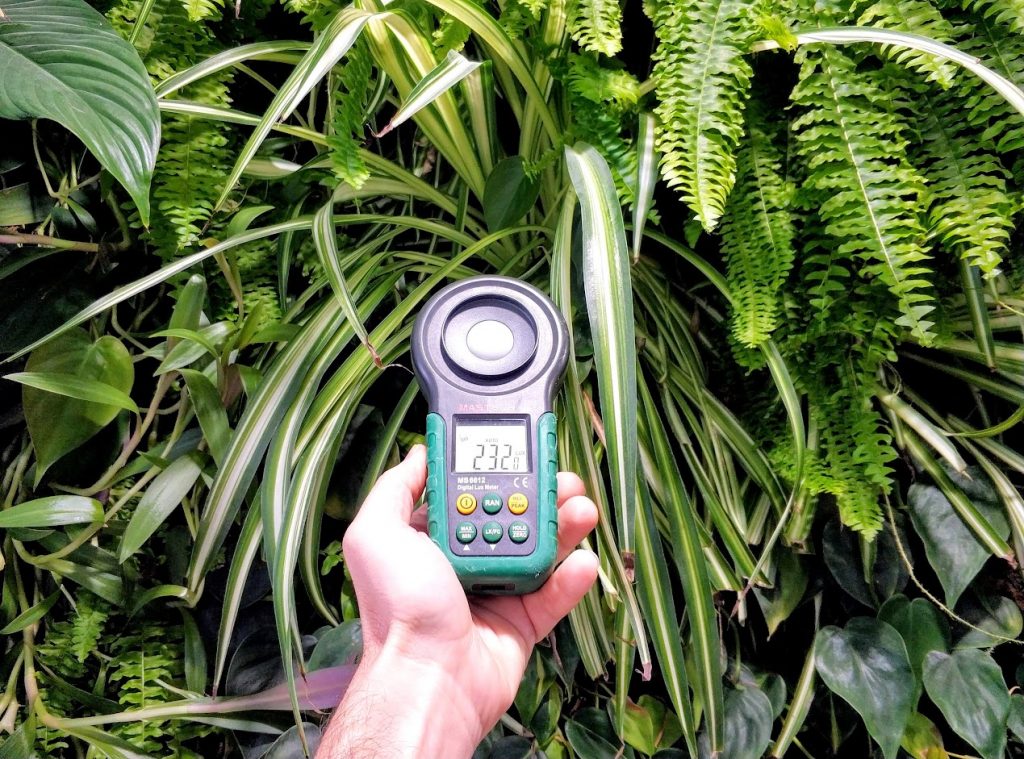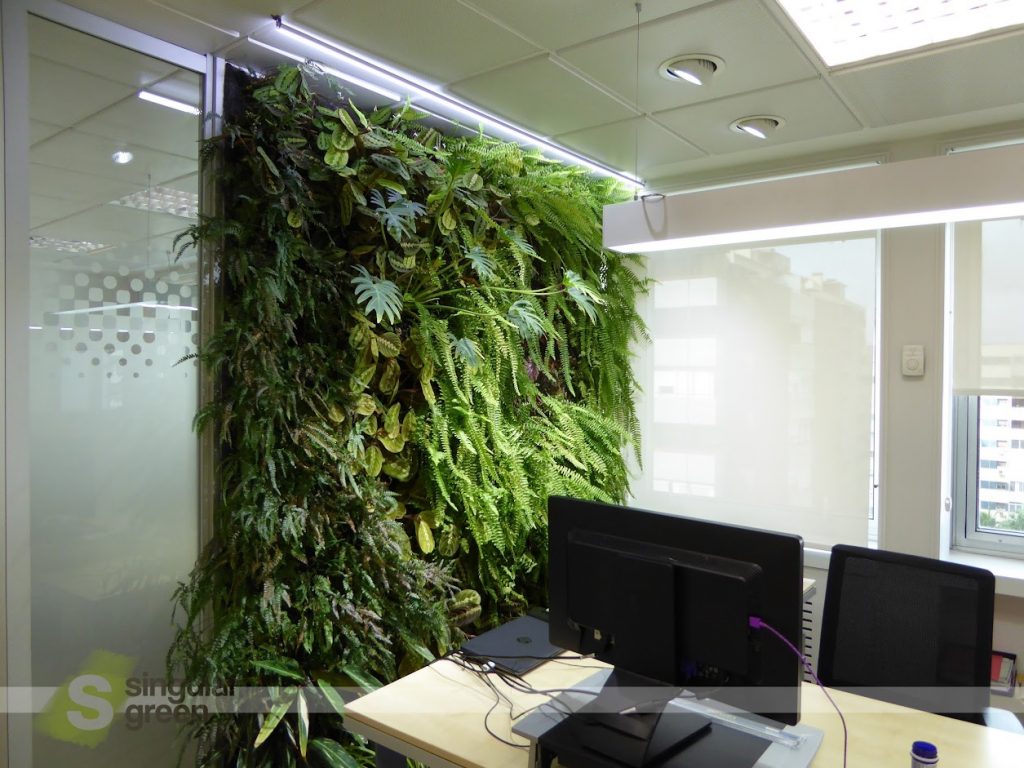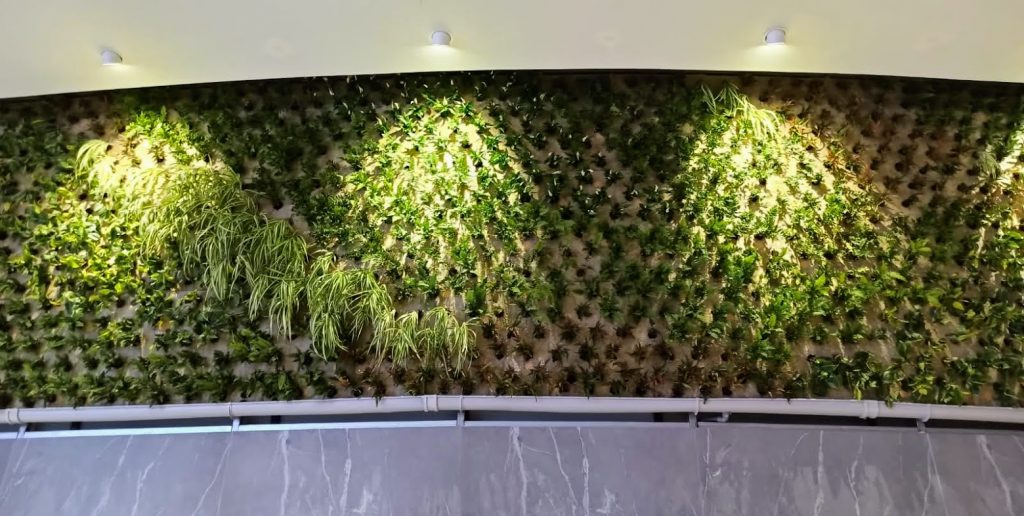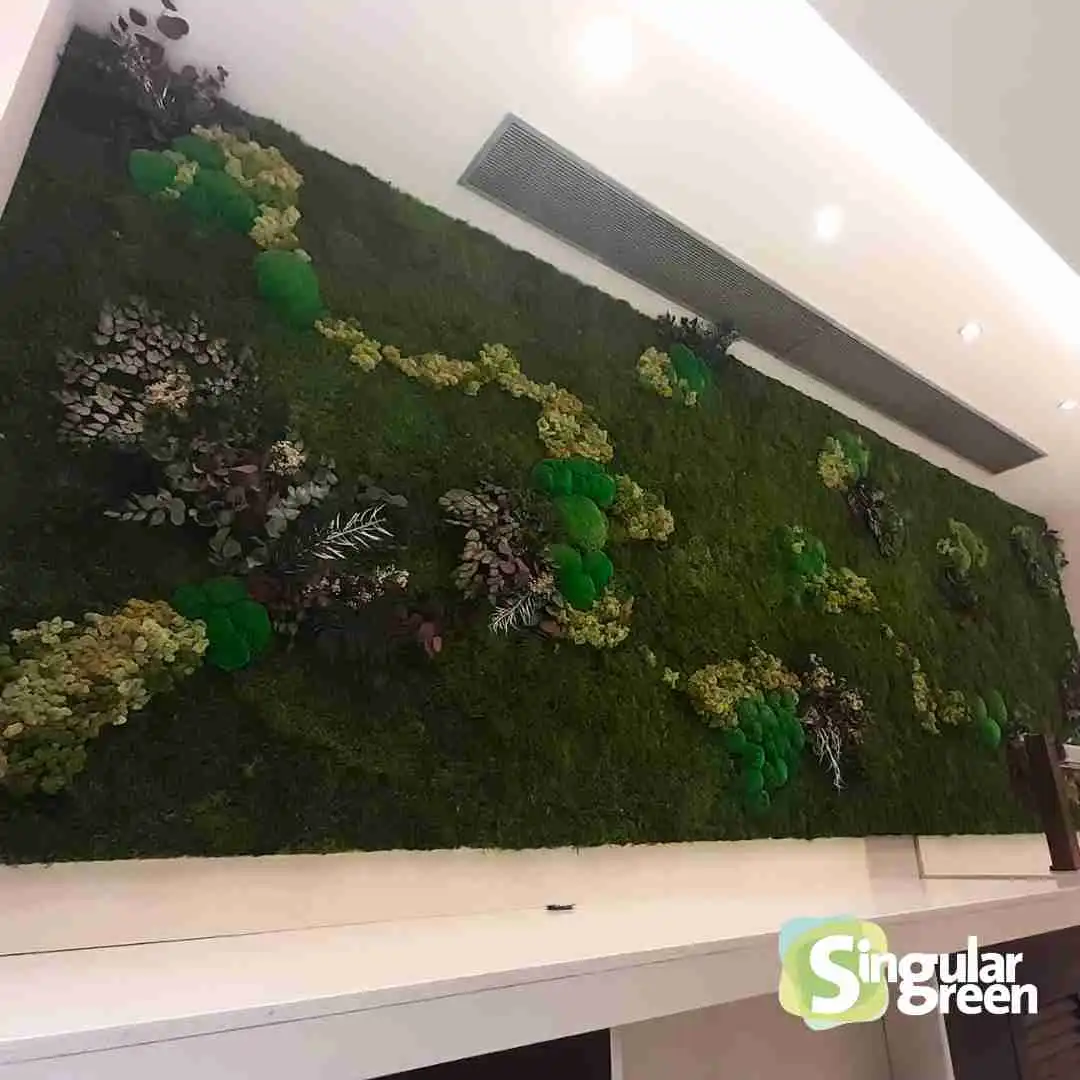In this article we are going to know everything about the lights of our vertical garden, the lighting of indoor vertical gardens.
Importance of lighting in vertical gardens
Lighting in vertical gardens is a crucial factor for the proper development of plants in this type of space. The amount of light, the duration of the illumination and the colour temperature are fundamental aspects to consider. The following are the key elements in relation to lighting in vertical gardens:
Light intensity and its influence on plant growth.
The amount of light required for proper plant growth is crucial for the growth of plants in vertical gardens. Adequate light intensity is essential to ensure photosynthesis and the proper growth process of plant species.
Amount of light needed for proper plant growth
Calculating the right amount of light is essential to ensure optimal plant growth in vertical gardens. It is important to ensure that plants receive the necessary amount of light to carry out their physiological processes optimally.
Lighting duration and its impact on plants
The duration of lighting in vertical gardens also plays a crucial role in plant growth. Controlling the time of light exposure is essential to simulate the natural cycle of light and dark that plants are used to, thus favouring their healthy development.
Colour temperature and its importance in photosynthesis
La temperatura de color de la iluminación en jardines verticales es un aspecto a considerar, ya que influye directamente en el proceso de fotosíntesis de las plantas. La elección de la temperatura de color adecuada puede potenciar la capacidad de las plantas para absorber la luz y llevar a cabo la fotosíntesis de forma eficiente.
Iluminación en un jardín vertical interior
Light is a key to the cultivation of indoor species (and any plant), some need more intense light than others. Without light there is no photosynthesis, which is the process by which plants produce their own food, the sugars (carbohydrates) that are consumed by all the cells in their tissues.
In this article we are going to learn about the most important aspects of lighting in indoor vertical gardens, where light needs are greater and knowledge of these needs is fundamental to the success of the vertical garden.
Lighting intensity for plants
Light intensity is measured in lux, the international unit of measurement which is equivalent to one lumen/m2.
The difference between lux and lumen is that lux takes into account the surface over which the luminous flux is distributed.
For example, if the lamp we use provides 1,000 lumens, and illuminates 1 square metre, we will have 1,000 lux on that surface. The same 1,000 lumens, distributed over 10 square metres, produces an illuminance of only 100 lux.

In other words, illuminating a larger area at the same lux level requires a higher number of lumens.
For indoor garden lighting we recommend a minimum intensity of between 2,000 and 2,500 lux over the entire surface of the garden, regardless of its origin, natural or artificial.
To measure the intensity of vertical gardens, we recommend the use of a lux meter, the device responsible for this.
Duration or time of light that plants require
The duration is the total time that plants receive light after 24 hours.
Photosynthesis in plants, in a very summarised way, is carried out in 2 phases: the dark phase and the light phase. Both can be carried out simultaneously, and both are necessary for the correct generation of energy. This is why there is no maximum duration for the lighting of the vertical garden, but only a minimum.
This factor is fundamental for the correct development of the vegetation, as a lack of lighting is fatal for the plants. This is why we recommend a minimum of 10 to 12 hours of lighting per day.
COLOUR TEMPERATURE
We could define colour temperature as the predominance of one of the colours of the light spectrum over the others, so that it alters the white colour towards red or blue in the light spectrum. What does this mean? Well, it means that light, whether natural or artificial, has a colour dominance that tends towards red (through yellow and orange), or towards blue (through white).

This is a factor that must be taken into account when artificially lighting a plant. Different types of artificial light produce very different wavelengths which have different effects on plant growth.
The colour temperature of a light source is defined by comparing its colour within the light spectrum with that of the light that would be emitted by a black body heated to a certain temperature. For this reason this colour temperature is expressed in Kelvin (K), although it does not expressly reflect a temperature measurement, since it is only a relative measurement.
A colour temperature of about 5,000K is that obtained by sunlight at midday. However, if we want to keep natural plants , our colour temperature should be close to 6,500K.
Recommended luminaires or lights for vertical gardens
Some time ago we were talking about the list of possible luminaires to use, their pros and cons and which one we recommend for each situation.
In that list we would see fluorescent tubes, energy saving lamps, metal halide lamps or sodium vapour lamps; but nowadays, and due to the drop in prices, we are only going to talk about LED lamps.

These LED lamps are perfect for indoor vertical garden installations as they have a number of advantages:
- Competitive price
- Low power consumption
- Low heat emission
- Wide choice of lamp and luminaire design possibilities
- Possibility of selecting colour temperature
For all of the above reasons, LEDs are the best choice of lamps today, and until technology advances and surprises us with other, better elements, we install LEDs.
Problems due to lack of light
Too much light:
Leaves on plants that receive too much light may scorch and have brown edges or brown spots; leaves may shrink in size and lose their green colour and become too whitish.
Another very common sign is shrivelling of the leaves. In general, the plant loses vigour and tends to turn its leaves away from the light.
An excess of light can also produce an exaggerated growth of the plant that makes additional pruning necessary, this can be a problem depending on the location and the use of the vertical garden.
Lack of light:
If the light level is too low, the leaves turn yellow and fall off. The plants hardly flower at all and, when they do, the flowers are often not fully developed and often fall off before flowering.

Problems due to lack of light
Plants often develop stems that are too long and too thin, with little vitality and with a large distance between internodes, i.e. the space from node to node. Generally the newly developed flowers may be too small, be born with different colouring or not appear at all.
Colour temperature:
In case of having a different colour temperature than the recommended one, we may find that the lights veer towards a low, cool or high, warm colour temperature.
When we have lights that tend towards a cooler spectrum we will find plants that widen their leaves and stems, and reduce the length of the internodes, creating ‘stubbier’ and more compact plants.
In lighting situations with a warmer spectrum, plants will produce smaller leaves and longer internodes, giving the impression of being in a low-light situation, even spiking and growing longer.
In both situations the plants will be subjected to unnecessary stress, which will affect their vegetative state and growth, favouring the appearance of pests and other health problems in our vertical garden.
Plants with low light requirements
Plants with low light requirements, which can live with artificial light of around 1,500 Lux.These are some of the species:
- Aglaonema – Aglaonema treubii, Aglaonema commutatum
- Alocasia – Alocasia sp.
- Aspidistra – Aspidistra elatior
- Calatea – Calathea makoyana
- Cinta – Chlorophytum comosum
- Ciso – Cissus rhombifolia
- Helecho pata de conejo – Davallia canariensis
- Poto – Epipremnum aureum
- Fitonia – Fittonia verschaffeltii
- Maranta – Maranta leuconeura
- Costilla de Adán – Monstera deliciosa
- Filodendro – Philodendron scandens
- Sanseviera – Sansevieria trifasciata
- Espatifilo – Spathiphyllum wallisii
- Singonio – Syngonium podophyllum
Improved lighting for indoor vertical gardens
Adequate lighting in indoor vertical gardens is essential to favour the development of plants. Here are some recommendations for effective lighting in this type of space:
Proper lighting control for indoor plants
- Use timers to regulate the duration of light and darkness, imitating the natural cycle of plants.
- Use light sensors to monitor the light intensity and adjust it according to the needs of the plants.
- Opt for full-spectrum LED light sources to promote healthy growth.
Additional tips for optimal indoor lighting
- Place lamps at an adequate distance from plants to avoid damage from excessive light.
- Evenly distribute light sources to ensure that all plants receive the necessary illumination.
- Consider the orientation of vertical gardens to make the best use of available natural light.
Tips for effective lighting in outdoor vertical gardens
Even light distribution
Even light distribution in outdoor vertical gardens is essential for balanced plant growth. Placing light sources strategically to avoid shaded areas and ensuring that all plants receive the same amount of light is key to their optimal development.
Importance of spectral distribution
In addition to the intensity and duration of lighting, spectral distribution is crucial in outdoor vertical garden lighting. Plants need different wavelengths of light to photosynthesise efficiently. Therefore, it is essential to choose light sources that emit a wide range of colours to meet the needs of plants at each stage of their growth.







